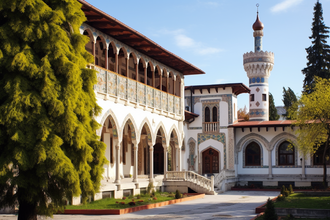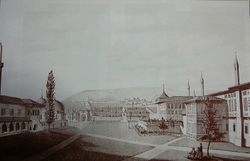Difference between revisions of "Hersheh Palace"
m |
|||
| (8 intermediate revisions by 3 users not shown) | |||
| Line 1: | Line 1: | ||
{{Infobox building | {{Infobox building | ||
|name= | |name=Hershah Palace | ||
|native_name= [[Koman language|Koman]]: '' | |native_name= [[Koman language|Koman]]: ''Hərşah Azanna'' | ||
|image= Kersheh.png | |image= Kersheh.png | ||
|image_caption= View of the palace from the courtyard | |image_caption= View of the palace from the courtyard | ||
| Line 7: | Line 7: | ||
|map_caption= | |map_caption= | ||
|coordinates = | |coordinates = | ||
|location_town=[[ | |location_town=[[Hasadyam]] | ||
|location_country=[[Komania]] | |location_country=[[Komania]] | ||
|address = | |address = | ||
|current_tenants=[[House of | |current_tenants=[[House of Ashar]] | ||
|architect= [[Shehyanli]] (presumably) | |architect= [[Shehyanli]] (presumably) | ||
|client= | |client= | ||
|engineer= | |engineer= | ||
|construction_start_date= | |construction_start_date=1568 | ||
|date_demolished= | |date_demolished= | ||
|cost= | |cost= | ||
|structural_system= | |structural_system= | ||
|style=[[ | |style=[[Asharid architecture|Asharid]], [[Ohanian architecture|Neoclassical Ohanian]] | ||
|size= | |size= | ||
|embedded= | |embedded= | ||
}} | }} | ||
The ''' | The '''Hershah palace''' or simply '''Summer palace''' is located in the resort town of [[Hasadyam]], [[Uzan]]. It was built in the 16th century by orders of emperor [[List of Koman monarchs|Geshukh]] as a summer palace. The walled palace contains a [[Gharam]], a vast garden, a cemetery and a ? along a vast complex of living quarters. The interior has been explicitly decorated with intricate woodwork and marble. The palace is noted for its lack of glazed tiles and extensive use of Bakhe roofs, making it an inspiration for the mid-17th century vernacular [[Architecture in Komania|Shavani style]]. | ||
[[File: | [[File:Kersheh photography.png|250px|thumbnail|left|Part of the living quarters.]] | ||
==History== | ==History== | ||
The Palace of | The Palace of Hershah was commissioned in 1566 by the Ashar dynasty under a selection of foreign planners supervised by the Koman architect [[Shehyanli]], the palace and its surrounding buildings make up around 120 hectares, comprising a [[Gharam]], 85 hectares of gardens, a cemetery and a Pagan temple with a vast network of residences for the emperor's family and servants' quarters, along with a channel and a bridge in the main entrance, including a front courtyard and a fountain with decorative tiles. | ||
Shortly after its completion in | Shortly after its completion in 1568, the palace became the preferred destination for a lineage of rulers from the [[House of Ashar|Ashar dynasty]] until the dissolution of the [[Great Horde]] in 1657. In 1660 the village and the palace fell to [[Samadar Mizarate|Samadari]] authority. Due to its lack of defences and geographic position, the palace changed hands several times and fell into decadence for the next 50 years, it wasn't until 1811, with the of the [[Imperial State]] that the village and the palace began to prosper again. | ||
[[File:Hersheh1820.jpg|250px|thumbnail| | [[File:Hersheh1820.jpg|250px|thumbnail|Drawing of the palace as it looked in 1852.]] | ||
==Present use== | ==Present use== | ||
While still under the tenant of the [[House of | While still under the tenant of the [[House of Ashar|Ashar dynasty]], the palace has been converted into a museum and a famous tourist attraction, with the [[Gharam]] preserving its original use. Due to its 50 years of decadence, the original furniture along with some architectural features was lost during several lootings, as a manner of compensation, replicas of such furniture and a large-scale restoration were devised by emperor [[List of Koman monarchs|Fadhamiz]] in 1940. | ||
==See also== | ==See also== | ||
*[[list of palaces in Komania]] | *[[list of palaces in Komania]] | ||
[[Category:Architecture]] [[Category:Komania]][[Category:Palaces of Komania]] | |||
Latest revision as of 10:39, 11 July 2023
| Hershah Palace | |
|---|---|
| Koman: Hərşah Azanna | |
 View of the palace from the courtyard | |
| General information | |
| Architectural style | Asharid, Neoclassical Ohanian |
| Town or city | Hasadyam |
| Country | Komania |
| Current tenants | House of Ashar |
| Construction started | 1568 |
| Design and construction | |
| Architect | Shehyanli (presumably) |
The Hershah palace or simply Summer palace is located in the resort town of Hasadyam, Uzan. It was built in the 16th century by orders of emperor Geshukh as a summer palace. The walled palace contains a Gharam, a vast garden, a cemetery and a ? along a vast complex of living quarters. The interior has been explicitly decorated with intricate woodwork and marble. The palace is noted for its lack of glazed tiles and extensive use of Bakhe roofs, making it an inspiration for the mid-17th century vernacular Shavani style.
History
The Palace of Hershah was commissioned in 1566 by the Ashar dynasty under a selection of foreign planners supervised by the Koman architect Shehyanli, the palace and its surrounding buildings make up around 120 hectares, comprising a Gharam, 85 hectares of gardens, a cemetery and a Pagan temple with a vast network of residences for the emperor's family and servants' quarters, along with a channel and a bridge in the main entrance, including a front courtyard and a fountain with decorative tiles.
Shortly after its completion in 1568, the palace became the preferred destination for a lineage of rulers from the Ashar dynasty until the dissolution of the Great Horde in 1657. In 1660 the village and the palace fell to Samadari authority. Due to its lack of defences and geographic position, the palace changed hands several times and fell into decadence for the next 50 years, it wasn't until 1811, with the of the Imperial State that the village and the palace began to prosper again.
Present use
While still under the tenant of the Ashar dynasty, the palace has been converted into a museum and a famous tourist attraction, with the Gharam preserving its original use. Due to its 50 years of decadence, the original furniture along with some architectural features was lost during several lootings, as a manner of compensation, replicas of such furniture and a large-scale restoration were devised by emperor Fadhamiz in 1940.

